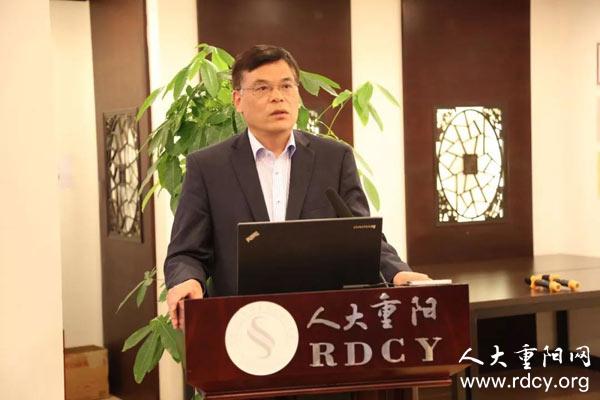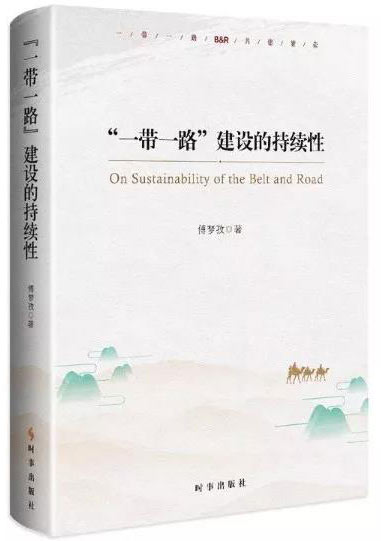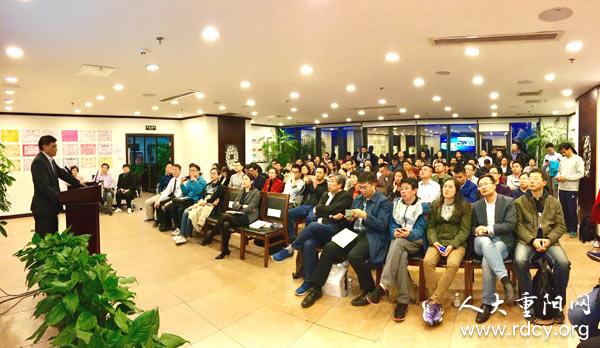Picture
Your Present Location: HOME> PictureFu Mengzi: On sustainability of the BRI construction
The past five years have seen consistent construction of the BRI project. Nowadays, the 2nd Belt and Road Forum for International Cooperation is scheduled to be held from April 25 to 27 in Beijing. President Xi delivered a keynote speech on the meeting of the fifth anniversary of the BRI in September 2018, declaring that the project construction has embarked on a concrete way. That means this summit serves as a mark that the project will unfold in a sweeping and conscientious manner. However, many headwinds and bottlenecks abound and lie ahead of us. To usher in a new and advanced era, we need to seek a prescription for that. Fu Mengxzi, deputy dean of the China Institute of Contemporary International Relations, was invited by Chongyang Institute for Financial Studies at Renmin University of China (RDCY), to make a specific analysis of the advanced era of the BRI from the special perspective of consistent construction.

Professor Fu holds an academic view that there exist some fundamental time nodes of the BRI project while interconnectivity remains as a consistent process which comes to no halt. In essence, improvements of interconnectivity ask for enduring effort. Therefore, the word “consistency” in her new book On sustainability of of the Belt and Road is defined as a state enabling something new to develop and even prosper.
Amid problems about the consistency arise from strong subjective wishes of all regions as well as uncertainties-ridden climate, it makes sense for us to overcome all challenges with help of own merits and propel the process in different times. Despite remarkable strides scored in past five years, China is still burdened with many new issues and challenges. Further development urges us to consider and resolve such inconsistent problem, which is of great significance. We are facing a world of uncertainties where complex and volatile landscape prevails, anti-globalization surges and a rollback trend goes viral among people. In fact, our theory research lags behind practice, which is attributable to initial aim of this research.

The first chapter of this book pursues the trace of the history from ancient silk road to modern times. It doesn’t only investigate the true history, but also answer two major issues of importance. The first point is historical reasons for the prosperity of the ancient silk road, and the second one represents fallback of this road. In other words, China will adopt what measures to guard against potential similar risks and threatens once ruining the ancient silk road in its BRI construction process.
International relation scholars should proceed from realistic care and policy sensitivity, reduce limits of history research and draw on wisdom from past experiences with a view to guiding policy practice in contemporary times. Research tells us that four reasons contribute to vicissitudes of the ancient silk road including wars, coup, limitations of regime, lack of economic complementarity of involved countries, and technology substitution. For Chinese today, will we encounter such challenges and how can we respond? All these should merit prudent attention of decision-makers and scholars.
The second chapter illustrates the inevitable trend for China to carry out the BRI construction and intensify its argument through case study in terms of framework design, heritage of road spirit, China’s neighbouring influence, potential for regional development and new drivers of new type of globalization. The following three parts constitute the body that further explains the lofty topic of the consistent BRI construction through three dimensions of endogenous power, adaptation, risk evaluation. The topic is in the transition from theory analysis to policy plans step by step.
As the core concept for understanding the consistency of the BRI construction, powerful and lasting endogenous power is extremely essential. Professor Fu demonstrates from four aspects in a systematic way: huge-scale economic spill-over effect, extension of value chains, fitness of channels, shortage of facilities and long-term construction. It is also important to be keenly aware of adaptation. The third chapter emphasizes effects of its physical strength and development trend on the consistent building of the BRI, and the fourth part highlights deep-seated influences from idealist elements such as concept, expectation, concern, shifts in international context on state-to-state cooperation potential and possible conflicts. The fifth chapter follows the idea and focuses on risk evaluation. Building on analysing features of risks and contribution and then concluding different evolution rules, Fu also discusses about models and manners of risks control. The last two chapters apply Go technique terms to identify focus of the BRI construction. In this connection, the priority lies in neighbouring regions as global geographical pivots, the pillar represents six major corridors and the main direction is the land as well as maritime silk road linking Asia with Europe. In closing, Fu proposes ten viable suggestions covering fields of domestic affairs and diplomacy.

More than 80 years ago, the Swedish scholar, Sven Hedin expected China to revive the ancient silk road once again with modern means of transportation and technology, contributing to Mankind and winning a good reputation worldwide. He signed with emotion and pointed that past imposing scenery had disappeared in the west and fresh scene would follow the rising sun, and reflect itself in the east.
Nowadays, Eurasia has undergone profound changes and such brilliant scene is beyond expected territory. It urges people not to seek zero-sum game or winners-take-all manner, instead pursue win-win cooperation based on global interconnectivity.
China has entered a new era when Xi thoughts will lead people to realize national rejuvenation., Great times is bound to generate great memory. Ancient silk road provides historical memory of exchanges between China with the rest of the world as it serves for trade and friendship. In friendly interaction with other ethnic groups, Chinese people have formed the road spirit featuring peaceful cooperation, openness, inclusiveness, mutual learning and win-win outcomes. The BRI will be an example of longstanding ancient silk road. It conforms to fundamental pursuits for a prosperous world so that its consistency will enable BRI to showcase the glory of interconnectivity of the world amid a new context of global environment.
The BRI marks the new model of China for communicating and interacting with others in a mutually beneficial manner. A great epoch is bound to win its reputation in the history.























































































 京公网安备 11010802037854号
京公网安备 11010802037854号





